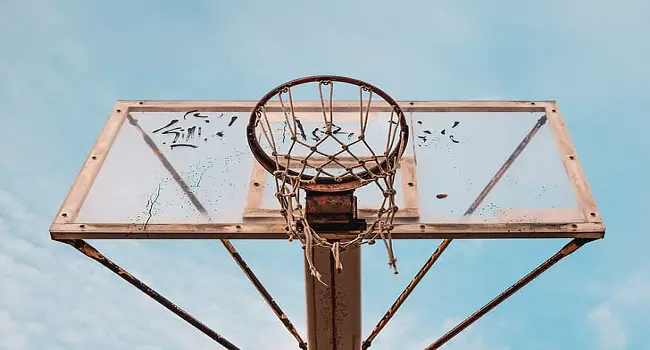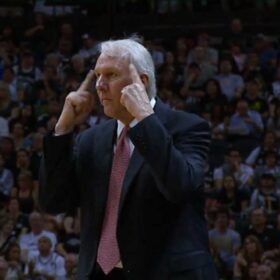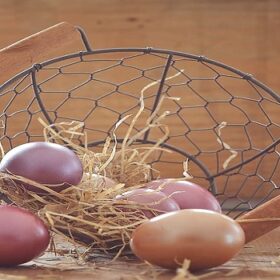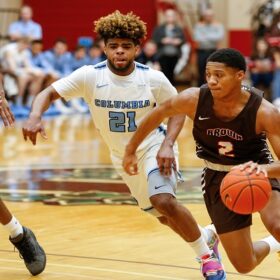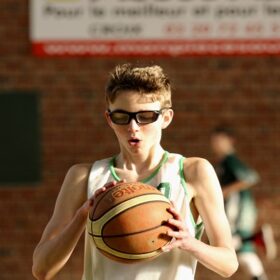Basketball has fast turned into one of the most popular sports around the world. It was very popular in the United States and Canada for many years and the growing passion and craze of the sport made its popularity extend to the other continents as well and now it is a one of the favorite games around the globe. With time, the game has had many changes in rules, playing style and skills.
For a novice, it would seem like every other thing you try turns into a foul, so it’s important to understand beforehand what every foul looks like. One of the most common mistakes made be beginners is in the Double Dribble. We’ll explain it in detail so you don’t go through the embarrassment of getting called out for a double dribble.
Double Dribble In Basketball
When we talk about basketball, an illegitimate dribble (popularly known as a double dribble or dribbling breach) takes place if a player finishes his dribble by catching the ball, and then starts dribbling again. This follows the basketball violation that one cannot make another dribble after settling the ball in his hands.
To indicate that a double dribble has been done by a player, the official would bring his hands out front with palms towards the floor and lift one hand upwards and the other one downwards. The Double Dribbling symbol in the basketball’s book of laws is the “illegal dribble” symbol.
Allowed Second Dribble
There are some instances where the player can continue dribbling even after he has caught the ball, finishing a first dribble. But these instances could be tricky to spot and memorize for a newbie. When a player ends his initial dribble to launch a shot which in turn hits the backboard or basketball net, a second dribble can be initiated. A player can also start another dribble if he loses command of the first dribble. It is due to a rival touching the ball or another player hits the ball.
History Of Double Dribble In Basketball
Dr. James Naismith himself expressed in a 1939 interview that people tried to play basketball before the laws were developed and published. He said it resulted in a big ruck with the players fighting, propelling, and flinging to grab the ball, the exact reverse of what he had hoped. Many players finished off with bruised eyes and injuries. Hence there was a need to lay down the rules plain and simple to keep the game civil as well as enjoyable.
Due to this, Naismith formulated the 13 official laws of basketball and he published them to the players’ gymnasium for viewing. The very first game, with the 13 original laws, came as official on December 21, 1891.
13 laws of basketball are:
- The player can toss the ball with any or both hands into either of the directions.
- A player ball can hit with any or both hands in either of the directions.
- A player can not sprint with the ball. He has to launch it through the position where he receives it. Its provision can be given for a person who collects the ball while trying to stop running at a fast pace.
- The ball should be grasped within or among the hands; it should not be utilized to support the arms or the body.
- There shouldn’t be any shouldering, keeping, hitting, forcing, or stumbling of a rival. The first violation of this law shall be qualified as a foul; the second will dismiss for the entire game before the next basket to score or if there has been an obvious attempt to harm the individual. No replacement is permitted.
- Hitting the ball with the fist is a foul, breach of laws three and four, and the kind mentioned in law five.
- In case any party commits three successive fouls, the rivals will get the score.
- A goal must be rendered whenever the ball is tossed knocked back from the floor into the basketball net. The ball remains there so that those who protect the goal do not contact or damage the goal. If the ball lies on the rim, and the rival is moving the basket, it will qualify as a goal.
- Whenever the ball moves out of borders, it is tossed into the playfield and handled by the first individual holding it. The umpire should toss it right into the ground in a circumstance of disagreement. A player will get five seconds to make the thrower-in. It could go to the competitor if kept for any longer. The umpire will call a foul on the party that persists in extending the game.
- The umpire will be the monitor. He will take notice of the fouls and inform the referee if there are three successive fouls. Under Rule 5, he will have the authority to dismiss.
- The referee must therefore be the ball’s monitor. He must determine whenever the ball is in use, in boundaries, to what party it belongs, and keep track of the time. He ultimately decides when a goal is made and must therefore retain track of the baskets, as well as other responsibilities that a score handler usually performs.
- The period would be two batches of fifteen minutes, with five minutes pause.
- Within this time, the party scoring the maximum points are the winner.
These initial 13 laws of basketball did not permit dribbling. Players were unable to run along with the ball. By 1910, the laws of basketball had been altered to enable players to run with the ball. But until 1916, dribblers were unable to launch the ball.
It took some time before dribbling caught on, and then came the problem of double dribbling. Players would dribble as long as they were away from a stopper. And as soon as they feel they were under check, they would catch the ball.
They will further wait for the threat to get away with and then start dribbling again. This made the game too easy for dribblers. Hence came the need to ban the double dribble.
What Causes Double Dribbling In Basketball?
According to the National Basketball Association (NBA), a dribble means the motion of a ball when a controlling player tosses or hits the ball either into the air or towards the ground.
They have mentioned that a dribble comes to an end if the player:
- Encounters the ball by using both hands concurrently.
- Allows the ball to settle when they own it.
- Connects to the ball several times whilst still dribbling, before it touching the floor.
According to FIBA (International Basketball Federation), a participant violates the rule if he dribbles again after his initial dribble is over except if he has lost sight of the ball on the playing area between the 2 dribbles due to:
- An attempt to make a field goal.
- A rival coming into contact with the ball.
- A transfer, or fumble, that has come into contact with some other player or if the other player has come into contact with it.
If such infringement does occur, the the authority rules will dictate any action against that violation. According to the laws of NCAA (National College Athletic Association), NFHS (National Federation of State High School Associations), and FIBA, if an unauthorized dribble infringement emerges, the ball will be of the rival’s team out of boundaries closest to the position where the violation occurred.
According to NBA laws, the ball can be at the closest location to the rival side, but no nearer to the finishing line than reached by the free shot line. If he commits any of these dribbling restrictions, the player in possession of the ball will be a double dribble perpetrator.
How To Prevent Double Dribble Violation In Basketball?
A double dribble in a basketball offense can often be challenging to prevent. Basketball is a quick reaction game involving a great deal of motion, speed, and absorption. If you lose concentration for even a moment, you might end up breaking the dribbling laws.
But there is nothing to worry about since we all make mistakes at some point. It is essential to realize where you were wrong and make attempts to fix it. That is why the double dribble rule is one of the first ones that the beginners must learn.
The key is to work on your dribbling skills so you never feel the need to hold the ball in your hand until you want to shoot or pass. If your ball control is strong and you are good enough at dribbling, you automatically won’t have to worry about the double dribble.
Conclusion
If you are just starting out, start with practicing your dribble. A double dribble is easy to commit, and quite embarrassing too. The best way to avoid it is to enhance your ball control.
You must always be ready to pass the ball to your teammate when in trouble. Baby steps, they say, and learning to dribble is the first towards making you a great Basketball player.

